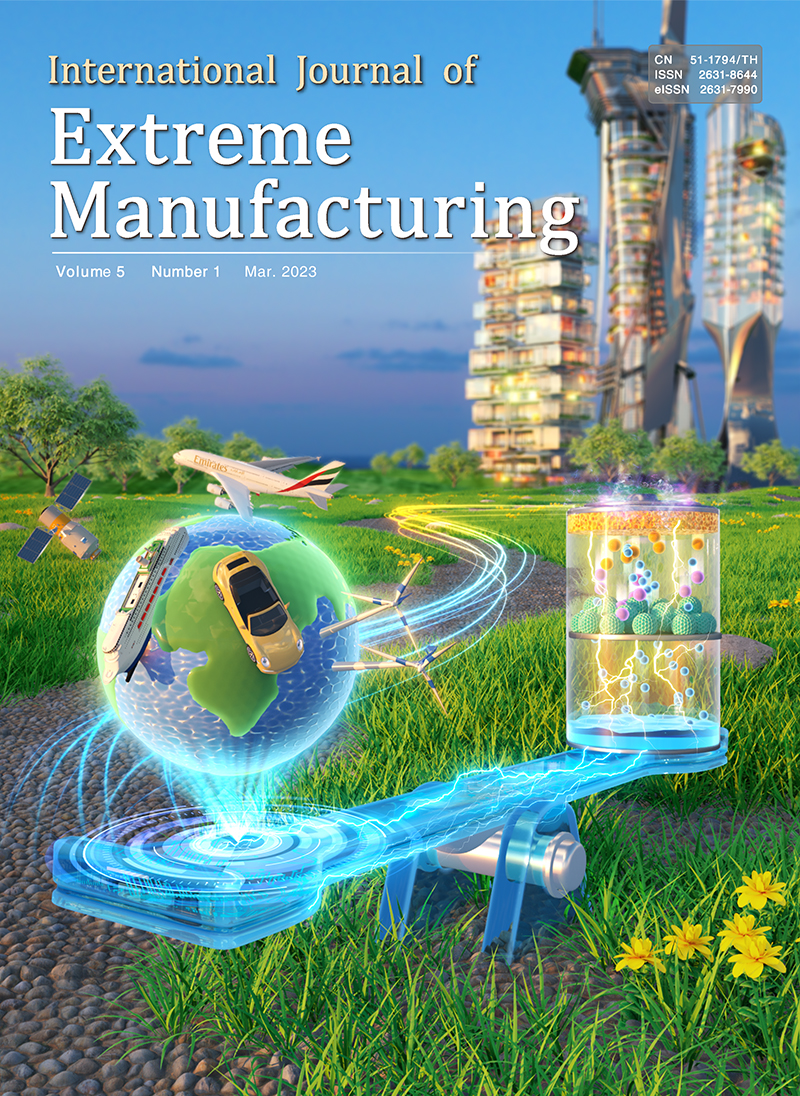Current Articles
2024, Volume 6, Issue 4
Triboelectric materials with high charge density are the building-block for the commercial application of triboelectric nanogenerators (TENGs). Unstable dynamic processes influence the change of the charge density on the surface and inside of triboelectric materials. The charge density of triboelectric materials depends on the surface and the internal charge transfer processes. The focus of this review is on recent advances in high charge density triboelectric materials and advances in the fabrication of TENGs. We summarize the existing strategies for achieving high charge density in triboelectric materials as well as their fundamental properties. We then review current optimization methods for regulating dynamic charge transfer processes to increase the output charge density: first, increasing charge injection and limiting charge dissipation to achieve a high average surface charge density, and second, regulating the internal charge transfer process and storing charge in triboelectric materials to increase the output charge density. Finally, we present the challenges and prospects in developing high-performance triboelectric materials.
Optical imaging systems have greatly extended human visual capabilities, enabling the observation and understanding of diverse phenomena. Imaging technologies span a broad spectrum of wavelengths from x-ray to radio frequencies and impact research activities and our daily lives. Traditional glass lenses are fabricated through a series of complex processes, while polymers offer versatility and ease of production. However, modern applications often require complex lens assemblies, driving the need for miniaturization and advanced designs with micro- and nanoscale features to surpass the capabilities of traditional fabrication methods. Three-dimensional (3D) printing, or additive manufacturing, presents a solution to these challenges with benefits of rapid prototyping, customized geometries, and efficient production, particularly suited for miniaturized optical imaging devices. Various 3D printing methods have demonstrated advantages over traditional counterparts, yet challenges remain in achieving nanoscale resolutions. Two-photon polymerization lithography (TPL), a nanoscale 3D printing technique, enables the fabrication of intricate structures beyond the optical diffraction limit via the nonlinear process of two-photon absorption within liquid resin. It offers unprecedented abilities, e.g. alignment-free fabrication, micro- and nanoscale capabilities, and rapid prototyping of almost arbitrary complex 3D nanostructures. In this review, we emphasize the importance of the criteria for optical performance evaluation of imaging devices, discuss material properties relevant to TPL, fabrication techniques, and highlight the application of TPL in optical imaging. As the first panoramic review on this topic, it will equip researchers with foundational knowledge and recent advancements of TPL for imaging optics, promoting a deeper understanding of the field. By leveraging on its high-resolution capability, extensive material range, and true 3D processing, alongside advances in materials, fabrication, and design, we envisage disruptive solutions to current challenges and a promising incorporation of TPL in future optical imaging applications.
Mg-Gd-Y-Zr alloy, as a typical magnesium rare-earth (Mg-RE) alloy, is gaining popularity in the advanced equipment manufacturing fields owing to its noticeable age-hardening properties and high specific strength. However, it is extremely challenging to prepare wrought components with large dimensions and complex shapes because of the poor room-temperature processability of Mg-Gd-Y-Zr alloy. Herein, we report a wire-arc directed energy deposited (DED) Mg-10.45Gd-2.27Y-0.52Zr (wt.%, GW102K) alloy with high RE content presenting a prominent combination of strength and ductility, realized by tailored nanoprecipitates through an optimized heat treatment procedure. Specifically, the solution-treated sample exhibits excellent ductility with an elongation (EL) of (14.6 ± 0.1)%, while the aging-treated sample at 200 ◦C for 58 h achieves an ultra-high ultimate tensile strength (UTS) of (371 ± 1.5) MPa. Besides, the aging-treated sample at 250 ◦C for 16 h attains a good strength-ductility synergy with a UTS of (316 ± 2.1) MPa and a EL of (8.5 ± 0.1)%. Particularly, the evolution mechanisms of precipitation response induced by various aging parameters and deformation behavior caused by nanoprecipitates type were also systematically revealed. The excellent ductility resulted from coordinating localized strains facilitated by active slip activity. And the ultra-high strength should be ascribed to the dense nano-β' hampering dislocation motion. Additionally, the shearable nano-β1 contributed to the good strength-ductility synergy. This work thus offers insightful understanding into the nanoprecipitates manipulation and performance tailoring for the wire-arc DED preparation of large-sized Mg-Gd-Y-Zr components with complex geometries.
Post-heat treatment is commonly employed to improve the microstructural homogeneity and enhance the mechanical performances of the additively manufactured metallic materials. In this work, a ternary (NiTi)91Nb9 (at.%) shape memory alloy was produced by laser powder bed fusion (L-PBF) using pre-alloyed NiTi and elemental Nb powders. The effect of solution treatment on the microstructure, phase transformation behavior and mechanical/functional performances was investigated. The in-situ alloyed (NiTi)91Nb9 alloy exhibits a submicron cellular-dendritic structure surrounding the supersaturated B2-NiTi matrix. Upon high-temperature (1273 K) solution treatment, Nb-rich precipitates were precipitated from the supersaturated matrix. The fragmentation and spheroidization of the NiTi/Nb eutectics occurred during solution treatment, leading to a morphological transition from mesh-like into rod-like and sphere-like. Coarsening of the β-Nb phases occurred with increasing holding time. The martensite transformation temperature increases after solution treatment, mainly attributed to: (i) reduced lattice distortion due to the Nb expulsion from the supersaturated B2-NiTi, and (ii) the Ti expulsion from the β-Nb phases that lowers the ratio Ni/Ti in the B2-NiTi matrix, which resulted from the microstructure changes from non-equilibrium to equilibrium state. The thermal hysteresis of the solutionized alloys is around 145 K after 20% pre-deformation, which is comparable to the conventional NiTiNb alloys. A short-term solution treatment (i.e. at 1 273 K for 30 min) enhances the ductility and strength of the as-printed specimen, with the increase of fracture stress from (613 ± 19) MPa to (781 ± 20) MPa and the increase of fracture strain from (7.6 ± 0.1)% to (9.5 ± 0.4)%. Both the as-printed and solutionized samples exhibit good tensile shape memory effects with recovery rates >90%. This work suggests that post-process heat treatment is essential to optimize the microstructure and improve the mechanical performances of the L-PBF in-situ alloyed parts.
Zinc (Zn) is considered a promising biodegradable metal for implant applications due to its appropriate degradability and favorable osteogenesis properties. In this work, laser powder bed fusion (LPBF) additive manufacturing was employed to fabricate pure Zn with a heterogeneous microstructure and exceptional strength-ductility synergy. An optimized processing window of LPBF was established for printing Zn samples with relative densities greater than 99% using a laser power range of 80 ∼ 90 W and a scanning speed of 900 mm s-1. The Zn sample printed with a power of 80 W at a speed of 900 mm s-1 exhibited a hierarchical heterogeneous microstructure consisting of millimeter-scale molten pool boundaries, micrometer-scale bimodal grains, and nanometer-scale pre-existing dislocations, due to rapid cooling rates and significant thermal gradients formed in the molten pools. The printed sample exhibited the highest ductility of ∼12.1% among all reported LPBF-printed pure Zn to date with appreciable ultimate tensile strength (~128.7 MPa). Such superior strength-ductility synergy can be attributed to the presence of multiple deformation mechanisms that are primarily governed by heterogeneous deformation-induced hardening resulting from the alternative arrangement of bimodal Zn grains with pre-existing dislocations. Additionally, continuous strain hardening was facilitated through the interactions between deformation twins, grains and dislocations as strain accumulated, further contributing to the superior strength-ductility synergy. These findings provide valuable insights into the deformation behavior and mechanisms underlying exceptional mechanical properties of LPBF-printed Zn and its alloys for implant applications.
3D printing techniques offer an effective method in fabricating complex radially multi-material structures. However, it is challenging for complex and delicate radially multi-material model geometries without supporting structures, such as tissue vessels and tubular graft, among others. In this work, we tackle these challenges by developing a polar digital light processing technique which uses a rod as the printing platform. The 3D model fabrication is accomplished through line projection. The rotation and translation of the rod are synchronized to project and illuminate the photosensitive material volume. By controlling the distance between the rod and the printing window, we achieved the printing of tubular structures with a minimum wall thickness as thin as 50 micrometers. By controlling the width of fine slits at the printing window, we achieved the printing of structures with a minimum feature size of 10 micrometers. Our process accomplished the fabrication of thin-walled tubular graft structure with a thickness of only 100 micrometers and lengths of several centimeters within a timeframe of just 100 s. Additionally, it enables the printing of axial multi-material structures, thereby achieving adjustable mechanical strength. This method is conducive to rapid customization of tubular grafts and the manufacturing of tubular components in fields such as dentistry, aerospace, and more.
NiTiCu-based shape memory alloys have been considered as ideal materials for solid-state refrigeration due to their superb cycling stability for elastocaloric effect. However, the embrittlement and deterioration caused by secondary phase and coarse grains restrict their applications, and it is still challenging since the geometric components are required. Here, bulk NiTiCuCo parts with excellent forming quality were fabricated by laser powder bed fusion (LPBF) technique. The as-fabricated alloy exhibits refined three-phases hierarchical microcomposite formed based on the rapid cooling mode of LPBF, composed of intricate dendritic Ti2Ni–NiTi composite and nano Ti2Cu embedded inside the NiTi-matrix. This configuration endows far superior elastocaloric stability compared to the as-cast counterpart. The low fatigue stems from the strong elastic coupling between the interphases with reversible martensite transformation, revealed by in-situ synchrotron high-energy x-ray diffraction. The fabrication of NiTiCuCo alloy via LPBF fills the bill of complex geometric structures for elastocaloric NiTiCu alloys. The understanding of interphase micro-coupling could provide the guide for designing LPBF fabricated shape memory-based composites, enabling their applications for special demands on other functionalities.
Amid the growing interest in triboelectric nanogenerators (TENGs) as novel energy-harvesting devices, several studies have focused on direct current (DC) TENGs to generate a stable DC output for operating electronic devices. However, owing to the working mechanisms of conventional DC TENGs, generating a stable DC output from reciprocating motion remains a challenge. Accordingly, we propose a bidirectional rotating DC TENG (BiR-TENG), which can generate DC outputs, regardless of the direction of rotation, from reciprocating motions. The distinct design of the BiR-TENG enables the mechanical rectification of the alternating current output into a rotational-direction-dependent DC output. Furthermore, it allows the conversion of the rotational-direction-dependent DC output into a unidirectional DC output by adapting the configurations depending on the rotational direction. Owing to these tailored design strategies and subsequent optimizations, the BiR-TENG could generate an effective unidirectional DC output. Applications of the BiR-TENG for the reciprocating motions of swinging doors and waves were demonstrated by harnessing this output. This study demonstrates the potential of the BiR-TENG design strategy as an effective and versatile solution for energy harvesting from reciprocating motions, highlighting the suitability of DC outputs as an energy source for electronic devices.



.55fa0c12-9b0d-4f27-8981-16d281adc3e4.png)
.a7bb8548-e258-4314-9f5d-447864b9287a.png)
.8cf00273-89ae-41f1-85b1-7b2ebf3687ec.png)
.d431d4c7-692a-4822-8685-8243b79d7b2d.png)
.a548e412-2b7e-4fec-a10c-b121832de9f5.png)
.6e559511-11e9-4b56-a11c-8314def08f47.png)
.14dd5660-0120-4821-afc1-258833bba755.png)
.91e4a4ec-32d7-4be1-a368-9bdcd2f8ce15.png)



